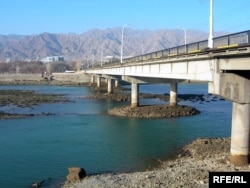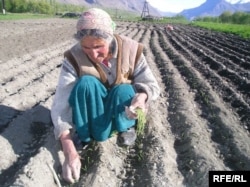Tajikistan's government has placed its hopes on completing a "project of the century" that could put an end to its chronic electricity shortages and make it a regional energy powerhouse.
Finishing the most crucial part of the undertaking, however -- the massive Roghun dam that was begun last century, during the Soviet era -- will require huge sums of money.
And with promised foreign aid failing to materialize, Tajik leaders have in desperation called on citizens of the impoverished country to help fund the initiative by donating a month's salary.
Nikolai Savchenkov, who was director of the project when it began in the late 1970s, tells RFE/RL that "Tajikistan's survival as an independent nation depends on the Roghun plant."
Savchenkov says that the project would "solve all economic problems" the country faces. First, it would enable Tajikistan to produce and sell electricity at a profit. Second, it would resolve chronic water-shortage problems.
"Dams around Roghun and the existing Nurek power plant will store enormous amount of water from the Vakhsh [River] over many years," Savchenkov says.
With an abundance of rivers and streams coursing through its mountainous terrain, estimates suggest Tajikistan is capable of producing 300 billion kilowatt-hours of electricity per year -- the greatest hydroelectric potential in Central Asia. Ironically, however, the country faces severe energy shortages every winter and depends on its neighbors to provide electricity.
Troubled Investment
Looking to remedy the situation, Dushanbe in recent years turned to Russia to help fund the completion of Roghun, a project originally designed to feed six power-generating units spanning the Vakhsh River in southern Tajikistan.
Capable of generating 3.6 billion kilowatts of electricity a year, Roghun was to be the most powerful hydroelectric plant in Central Asia and, at 335 meters, the world's highest dam. But shortly before the collapse of the Soviet Union, the project was frozen and remains unfinished.
In 2007 a contract was signed with Russian aluminum giant RusAl to resume the project. But the deal was cancelled due to disagreements over the scale of the project amid strong opposition from neighboring Uzbekistan, which has argued that the dam could threaten environmental disaster for the region and leave the downstream country with severe water shortages.
But a number of countries in the region, including China, Afghanistan, and Pakistan, have expressed their willingness to import Tajik electricity, and Roghun's massive reservoir could be a way to alleviate seasonal water shortages, so Tajik politicians are undeterred.
Public Fund Raising
Now Mahmadsaid Ubaildulloev, the head of the upper chamber of the Tajik parliament, has suggested that if all Tajik workers were to donate one month's salary, this would generate $154 million toward finishing the Roghun project.
That would add to the $130 million the Tajik government has already allocated to fund Roghun's construction in its 2010 budget.
While an estimated $3 billion would be needed to complete the project as originally envisioned, with all six generating units, Tajik leaders are adamant that at least two units can be completed over the next five years using domestic funds.
Earlier this month, President Emomali Rahmon said he was confident that the Tajik people "will do everything they can to help complete" the Roghun project.
Tajik lawmakers have expanded the effort by calling on people to buy shares in Roghun that would be made available for trading on the country's stock market in 2010.
According to Tajik media reports, public-sector workers in some areas have already begun contributing money to the Roghun project, while others, including the Islamic Renaissance Party, have announced their intention to purchase Roghun shares.
'Why Should We Pay?
In a country where the average monthly salary is about $80, not everyone is happy with the prospect of having to donate money to Roghun or obtain its shares.
Kodir Khojaev, a businessman in the northern town of Khujand, says that he "couldn't care less about what happens in five years, I have more immediate problems to take care of."
"Most Tajiks live in poverty and our earnings are hardly enough to buy food," Khojaev says. "Besides, how can I trust the government that it will complete Roghun in five years? We've heard these kinds of empty promises before."
With a gross domestic product per capita of about $1,800, Tajikistan is one of the poorest former Soviet countries.
Khojaev wonders why Tajikistan cannot use aid allocated from outside sources to fund the project.
"International organizations and financial institutions, such as the Asian Development Bank and others, allocate huge amounts of money to Tajikistan's development. We know about them from media reports," Khojaev says.
"Instead of asking for donations from the people, our leaders, who dub Roghun the 'project of the century,' should use that foreign investment in this project."
Khojaev's household, like other in the country, has been limited to five hours of electricity a day since the annual six-month rationing period began in early November.
His remarks represent the views of many ordinary Tajiks, who say they no longer expect the government to resolve the country's electricity crisis.
Khojimuhammad Umarov, a Dushanbe-based expert on the Tajik economy, tells RFE/RL that Roghun would solve the country's energy problem "once and for all."
But Umarov also says that Tajikistan would have to cooperate with its neighbors if it wanted to achieve its goal of making money from electricity exports.
"Kazakhstan and Turkmenistan have in the past mentioned their readiness to invest in Roghun," Umarov says. "Tajikistan has to ask these two countries to step in now to invest."
Tajikistan also has other hydropower plants under construction, including Sangtuda-1 and Sangtuda-2, which are mostly owned by Russia and Iran, respectively. Sangtuda-1 has been partially completed and has started producing electricity.
Finishing the most crucial part of the undertaking, however -- the massive Roghun dam that was begun last century, during the Soviet era -- will require huge sums of money.
And with promised foreign aid failing to materialize, Tajik leaders have in desperation called on citizens of the impoverished country to help fund the initiative by donating a month's salary.
Nikolai Savchenkov, who was director of the project when it began in the late 1970s, tells RFE/RL that "Tajikistan's survival as an independent nation depends on the Roghun plant."
Savchenkov says that the project would "solve all economic problems" the country faces. First, it would enable Tajikistan to produce and sell electricity at a profit. Second, it would resolve chronic water-shortage problems.
"Dams around Roghun and the existing Nurek power plant will store enormous amount of water from the Vakhsh [River] over many years," Savchenkov says.
With an abundance of rivers and streams coursing through its mountainous terrain, estimates suggest Tajikistan is capable of producing 300 billion kilowatt-hours of electricity per year -- the greatest hydroelectric potential in Central Asia. Ironically, however, the country faces severe energy shortages every winter and depends on its neighbors to provide electricity.
Troubled Investment
Looking to remedy the situation, Dushanbe in recent years turned to Russia to help fund the completion of Roghun, a project originally designed to feed six power-generating units spanning the Vakhsh River in southern Tajikistan.
Capable of generating 3.6 billion kilowatts of electricity a year, Roghun was to be the most powerful hydroelectric plant in Central Asia and, at 335 meters, the world's highest dam. But shortly before the collapse of the Soviet Union, the project was frozen and remains unfinished.
In 2007 a contract was signed with Russian aluminum giant RusAl to resume the project. But the deal was cancelled due to disagreements over the scale of the project amid strong opposition from neighboring Uzbekistan, which has argued that the dam could threaten environmental disaster for the region and leave the downstream country with severe water shortages.
But a number of countries in the region, including China, Afghanistan, and Pakistan, have expressed their willingness to import Tajik electricity, and Roghun's massive reservoir could be a way to alleviate seasonal water shortages, so Tajik politicians are undeterred.
Public Fund Raising
Now Mahmadsaid Ubaildulloev, the head of the upper chamber of the Tajik parliament, has suggested that if all Tajik workers were to donate one month's salary, this would generate $154 million toward finishing the Roghun project.
That would add to the $130 million the Tajik government has already allocated to fund Roghun's construction in its 2010 budget.
While an estimated $3 billion would be needed to complete the project as originally envisioned, with all six generating units, Tajik leaders are adamant that at least two units can be completed over the next five years using domestic funds.
Earlier this month, President Emomali Rahmon said he was confident that the Tajik people "will do everything they can to help complete" the Roghun project.
Tajik lawmakers have expanded the effort by calling on people to buy shares in Roghun that would be made available for trading on the country's stock market in 2010.
According to Tajik media reports, public-sector workers in some areas have already begun contributing money to the Roghun project, while others, including the Islamic Renaissance Party, have announced their intention to purchase Roghun shares.
'Why Should We Pay?
In a country where the average monthly salary is about $80, not everyone is happy with the prospect of having to donate money to Roghun or obtain its shares.
Kodir Khojaev, a businessman in the northern town of Khujand, says that he "couldn't care less about what happens in five years, I have more immediate problems to take care of."
"Most Tajiks live in poverty and our earnings are hardly enough to buy food," Khojaev says. "Besides, how can I trust the government that it will complete Roghun in five years? We've heard these kinds of empty promises before."
With a gross domestic product per capita of about $1,800, Tajikistan is one of the poorest former Soviet countries.
Khojaev wonders why Tajikistan cannot use aid allocated from outside sources to fund the project.
"International organizations and financial institutions, such as the Asian Development Bank and others, allocate huge amounts of money to Tajikistan's development. We know about them from media reports," Khojaev says.
"Instead of asking for donations from the people, our leaders, who dub Roghun the 'project of the century,' should use that foreign investment in this project."
Khojaev's household, like other in the country, has been limited to five hours of electricity a day since the annual six-month rationing period began in early November.
His remarks represent the views of many ordinary Tajiks, who say they no longer expect the government to resolve the country's electricity crisis.
Khojimuhammad Umarov, a Dushanbe-based expert on the Tajik economy, tells RFE/RL that Roghun would solve the country's energy problem "once and for all."
But Umarov also says that Tajikistan would have to cooperate with its neighbors if it wanted to achieve its goal of making money from electricity exports.
"Kazakhstan and Turkmenistan have in the past mentioned their readiness to invest in Roghun," Umarov says. "Tajikistan has to ask these two countries to step in now to invest."
Tajikistan also has other hydropower plants under construction, including Sangtuda-1 and Sangtuda-2, which are mostly owned by Russia and Iran, respectively. Sangtuda-1 has been partially completed and has started producing electricity.


















